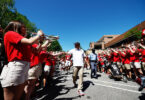Athens, Ga. – The Georgia Museum of Art at the University of Georgia will present “A Divine Light: Northern Renaissance Paintings from the Bob Jones University Museum and Gallery,” an exhibition organized by the Frist Center for the Visual Arts and Bob Jones University Museum and Gallery, from March 17 to July 29.
“A Divine Light” presents 28 works of art from one of the finest collections of Old Master paintings in the Southeast. This exhibition, which features the devotional art of the 15th and 16th centuries from the modern day countries of Belgium, France, Germany, the Netherlands and Spain, investigates the ways in which Northern Renaissance artists expressed mysteries of the Christian faith through setting, pose, gesture and the objects of everyday life.
The museum invites church groups and others to schedule free tours of the exhibition with its department of education by calling 706/542.GMOA (4662), emailing Melissa Rackley at mrackley@uga.edu, or through the website at http://www.georgiamuseum.org/visit/tours.
Bob Jones Jr. (1911-1997), the second president of Bob Jones University, had a strong interest in the arts and founded the campus art museum in 1951, the same year he began collecting Northern Renaissance paintings. According to Trinita Kennedy, associate curator at the Frist Center, since the late 1960s, it has been increasingly difficult for museums and collectors throughout the world to purchase Old Master paintings because of rising prices and scarcity. However, Jones continued acquiring Northern Renaissance paintings for his museum until the year of his death.
This exhibition presents approximately one quarter of the Northern Renaissance paintings in the Bob Jones Collection. They range from a tiny devotional panel likely used by nuns cloistered in a convent to a triptych that most likely ornamented a side altar in a church. Most are small- to medium-sized panels made for use in a domestic setting by members of the upper middle class. A particularly large number of paintings were created by artists working in the Netherlandish cities of Antwerp or Bruges, where popular subjects such as the Virgin and Child and the Crucifixion were produced for sale on the open market.
Kennedy points out that Northern artists were early to embrace oil painting. At the start of the 15th century, they were beginning to use oil rather than egg yolk as the binding agent for their pigments, and their masterful use of the medium makes their paintings appear to glow from within. Oil paint served as a means through which these artists were able to mimic virtually every aspect of the material world. The illusionism of Northern Renaissance paintings and the ways in which they appeal to the senses enable viewers to have a particularly close encounter with the subjects portrayed.
This exhibition and its accompanying catalogue were made possible in part by the Samuel H. Kress Foundation in New York. The W. Newton Morris Charitable Foundation and the Friends of the Georgia Museum of Art sponsor it locally.
Museum Information
Partial support for the exhibitions and programs at the Georgia Museum of Art is provided by the Georgia Council for the Arts through appropriations of the Georgia General Assembly. The council is a partner agency of the National Endowment for the Arts. Individuals, foundations and corporations provide additional museum support through their gifts to the University of Georgia Foundation. The Georgia Museum of Art is located in the Performing and Visual Arts Complex on the East Campus of the University of Georgia. The address is 90 Carlton Street, University of Georgia, Athens, Ga. 30602-6719. For more information, including hours, see http://www.georgiamuseum.org or call 706/542.GMOA (4662).







